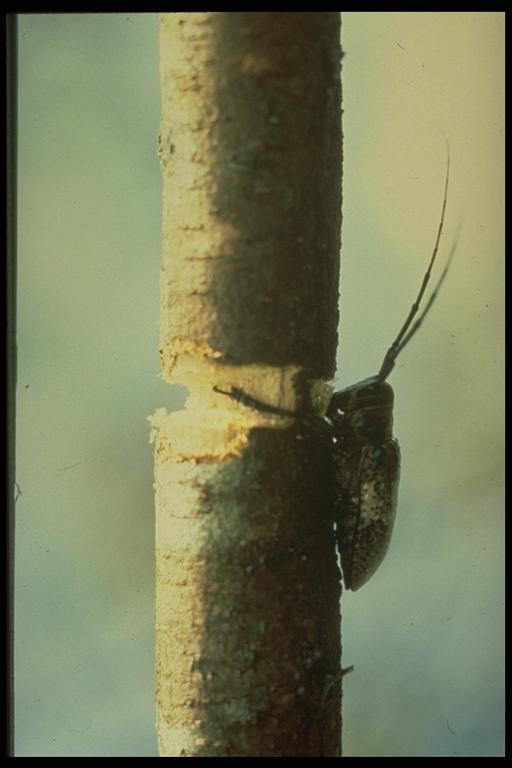
Twig girdler, Oncideres pustulatus LeConte (Coleoptera: Cerambycidae), female. Photo by M. E. Rice.
Common Name: Twig girdler
Scientific Name: Oncideres pustulatus LeConte
Order: Coleoptera
Description: These beetles are 1/2 to 3/4 inch long, light to dark brown with a wide gray band across the wing covers (elytra) and a dense sprinkling of pink, orange or dark yellow spots. They have long antennae, being members of the longhorned beetle family, Cerambycidae. The pecan girdler occurs throughout Texas except in the trans-Pecos area.
Mesquite twig girdlers, Oncideres rhodosticta Bates, are similar in appearance to pecan twig girdlers, but can be distinguished from the pecan twig girdler by the presence of three shiny, black dots immediately behind the head. It is found in the southern Rolling Plains and prefers to feed on mesquite and several acacia species. The huisache girdler, O. pustulatus LeConte, is 11/16 to 1 1/8 inches long, brown with a light brown band across the middle of the upper surface of the body and peppered with small, shiny black dots. It is found in the Gulf Coast Prairie, south Texas and Rio Grande Valley and injures mostly mimosa and huisache.
Life Cycle: Adults appear from late August through October. After mating, females select a host plant, chewing a clean-cut “V”-shaped groove around a branch. Thereafter, they crawl above the girdled site and insert cream-colored oval eggs singly into notches chewed into the bark. Larvae hatch from eggs in about 7 days and begin tunneling underneath the bark. Larvae grow through several stages (instars) through the year before transforming into pupae the following summer. A few of the larvae do not complete development until May or June of the second year, which accounts for a small amount of girdling damage occurring in the spring.
Habitat and Food Source(s): Mouthparts are for chewing. Pecan twig girdlers attack citrus, elm, hackberry, hickory, huisache, mimosa, pecan, persimmon, red oak, retama, tepehuaje, Texas ebony, walnut and various fruit trees. Twigs selected by female beetles to girdle range in diameter from 9-12 mm. Severe girdling can disfigure trees. Damage appears mainly in late summer and fall when adult beetles are active. Leaves on the girdled branches turn die and fall, and the branches often fall from the tree during high winds and storms. Beetles are not commonly encountered on trees. They are attracted to lights.
Pest Status, Damage: Females chew a groove around the circumference of small branches (9-12 mm), “girdling” them, thereby killing injured parts of trees; injured branches eventually fall from the tree; larvae feed inside the dead injured tree part and are not a threat to tree health; medically harmless.
For additional information, contact your local Texas A&M AgriLife Extension Service agent or search for other state Extension offices.
Literature: Rice & Drees. 1990. Rice 1995. Rice 1989.